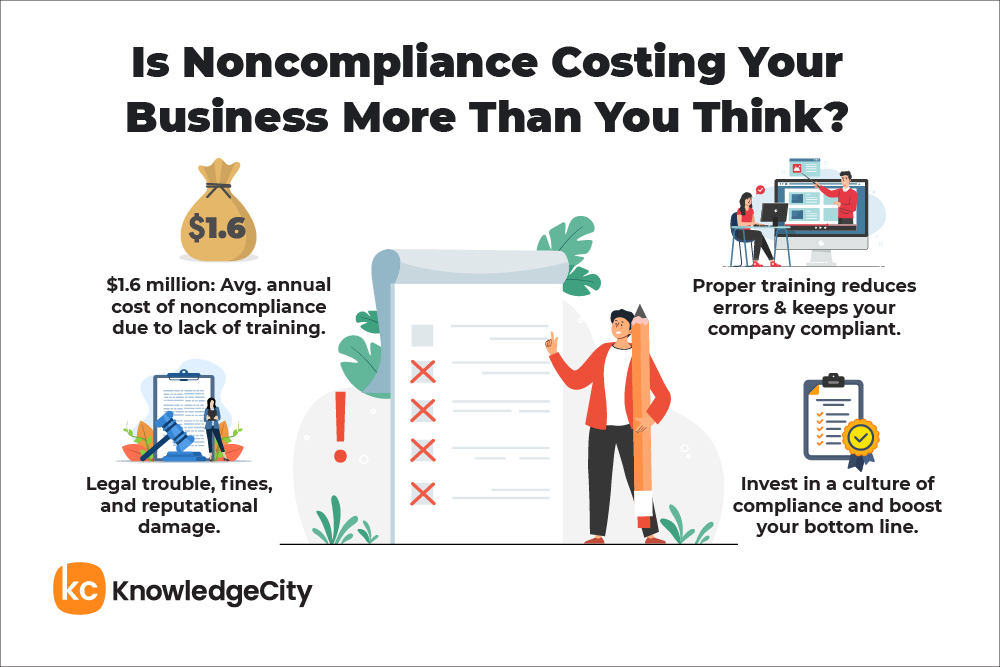Making sure your company follows rules and regulations is very important. With laws always changing, it’s tough to keep up and ensure your business stays legal. Breaking rules can lead to serious consequences like legal trouble, fines, and a damaged reputation.
But there’s another side to it: not following the rules can also hurt your finances. In this article, we’ll discuss how breaking the rules can cost your business a lot of money, especially if your employees aren’t trained properly.

What is Noncompliance?
Noncompliance occurs when someone fails or refuses to follow a rule, regulation, or agreement. This can happen in different settings, such as legal and medical contexts, workplaces, or personal relationships.
In the workplace, noncompliance refers to employees or the company itself not following the established rules and regulations. These rules can cover various aspects: of the work environment:
-
- Company Policies and Procedures: These include dress codes, expense reporting guidelines, internet usage policies, or anti-discrimination policies.
-
- Safety Regulations: It’s essential to follow safety protocols set by the government (like OSHA) or the company itself to prevent accidents and injuries.
-
- Industry Standards: Certain professions may have specific industry standards that employees are expected to adhere to.
- Legal Regulations: Labor laws, data privacy laws, and other legal requirements all fall under compliance for businesses.
Noncompliance can also manifest in a few ways, including deliberate disregard for the rules. This occurs when an employee knowingly breaks the rules, such as taking extended breaks without permission or falsifying expense reports.
The lack of training can also contribute to noncompliance. If proper training on procedures or regulations isn’t provided, employees may not understand what is expected of them. This results in unintentional mistakes as employees might violate policies due to their lack of awareness. An employee might also make a safety oversight due to stress or fatigue.
The consequences of noncompliance can vary depending on the situation, but they often involve financial penalties or negative outcomes. This is why it’s essential to ensure your employees are equipped with the right skills and knowledge to prevent any issues from arising..
The Consequences of Noncompliance
Noncompliance can lead to various consequences, such as legal sanctions, fines, and harm to your company’s reputation. These outcomes can be costly and significantly impact your business’s financial standing. Here are some ways your company may be affected by noncompliance:
- Legal Sanctions and Fines: Noncompliance poses a risk of legal penalties and fines, which can range from thousands to millions of dollars depending on the severity of the violation. Additionally, it may result in legal sanctions like court orders or injunctions.
- Safety Risks: Neglecting safety protocols can result in workplace accidents and injuries, costing your organization thousands of dollars. Workplace illnesses and injuries can cost the U.S. up to $250 million annually, according to the Economic Policy Institute.
- Decreased Productivity: A culture of noncompliance can undermine trust and create a chaotic work environment, leading to decreased productivity. When employees feel unsafe, it may lead to disengagement and reduced commitment..
- Disciplinary Actions: Employees who repeatedly violate policies may face disciplinary measures, including efforts to fix their behavior which, if unsuccessful, could lead to their termination. High turnover rates due to noncompliance can be costly, with the cost of replacing an employee ranging from one-half to two times their annual salary, according to Gallup.
- Damage to Reputation: Noncompliance can tarnish your company’s reputation, eroding the trust of customers, partners, and investors alike. This in turn leads to fewer sales and a decline in revenue. It may also hinder your efforts to recruit and retain top talent, as employees may be wary of working for a company that’s being willfully noncompliant..
The Importance of Employee Training
To avoid the hidden costs of noncompliance, it’s essential to invest in employee training. Properly training your employees on compliance regulations can reduce the risk of errors and helps to ensure your company remains compliant. Here’s how adequate training can diminish the risk of noncompliance::
- Stay Up-to-Date on Regulations: Regulations and legal requirements are continually evolving, which can pose a challenge when you’re trying to stay current. Regular training sessions for employees can keep them informed of any changes and help them understand how to adapt their existing routines accordingly.
- Create a Culture of Compliance: Employee training can also help establish a culture of compliance within your company. When employees grasp the significance of compliance and receive training on how to adhere to regulations, they are more inclined to follow ethical standards.
- Reduce the Risk of Errors: Proper training can also help reduce the risk of errors that can lead to noncompliance. By providing employees with the knowledge and skills they need to comply with regulations, you can minimize the risk of costly errors.
Training employees on compliance regulations can be done in several ways:
- Online Training: This method is cost-effective and convenient. Employees can complete training at their own pace, minimizing disruptions to productivity.
- In-Person Training: In-person training allows for more interaction and engagement with employees, making it an effective way to train on complex compliance regulations. However, in-person training can be more costly and time-consuming than online training.
- Gamification: Gamification is a popular training method that uses game-like elements to engage and motivate employees. By incorporating elements such as points, levels, and rewards, gamification can make compliance training more enjoyable and effective.
Improving Your Compliance Training
Ensuring compliance within an organization is no longer a simple checkbox exercise. It’s a strategic investment that can unlock a multitude of benefits. While avoiding penalties and legal repercussions is a significant advantage, a strong compliance training program offers far more. Let’s dive deeper into the ways a commitment to compliance can transform your workplace:
-
- Clear Communication and Resources: Establish easily understandable policies and procedures. Provide employee handbooks, clear guidelines, and access to resources like templates or checklists. Regularly communicate these policies and updates.
-
- Engaging Training: Invest in regular, engaging training sessions. Tailor training to different roles and responsibilities and ensure it goes beyond a one-time event. Use interactive methods, case studies, and refresher courses to reinforce understanding..
-
- Culture of Openness: Create an environment where employees feel comfortable asking questions and raising concerns about compliance issues. Use open-door policies, anonymous reporting channels, and encourage discussions during training or meetings to promote open communication..
-
- Leadership by Example: Management sets the tone for compliance. When leaders consistently follow the rules and demonstrate a commitment to ethical practices, it reinforces a culture of accountability..
- Positive Reinforcement: Recognize and celebrate instances of good behavior. Use recognition programs or small rewards to motivate employees to consistently follow compliance protocols.
By implementing these strategies, you can create a workplace environment where compliance is not just a box to check, but an integrated part of everyday work practices. This leads to a more ethical and responsible organization, while minimizing legal and financial risks.
Strengthening Compliance with KnowledgeCity
By implementing these strategies, you can establish a workplace environment where compliance is integrated into everyday work practices, not just a checkbox item. This promotes a more ethical and responsible organization while reducing legal and financial risks.
Noncompliance can result in serious consequences, including legal sanctions, fines, and damage to your company’s reputation. However, the hidden costs of noncompliance, such as productivity loss, employee turnover, and increased insurance costs, can be even more significant.
To avoid these hidden costs, invest in employee training and nurture a culture of compliance at your company. Stay updated on regulations and provide employees with the necessary knowledge and skills to comply. This protects your business and its bottom line. To learn more about effective employee compliance training, request a demo from KnowledgeCity today.
Subscribe to Our Newsletter
Join 80,000+ Fellow HR Professionals. Get expert recruiting and training tips straight
to your inbox, and become a better HR manager.

 KnowledgeCity
KnowledgeCity 










